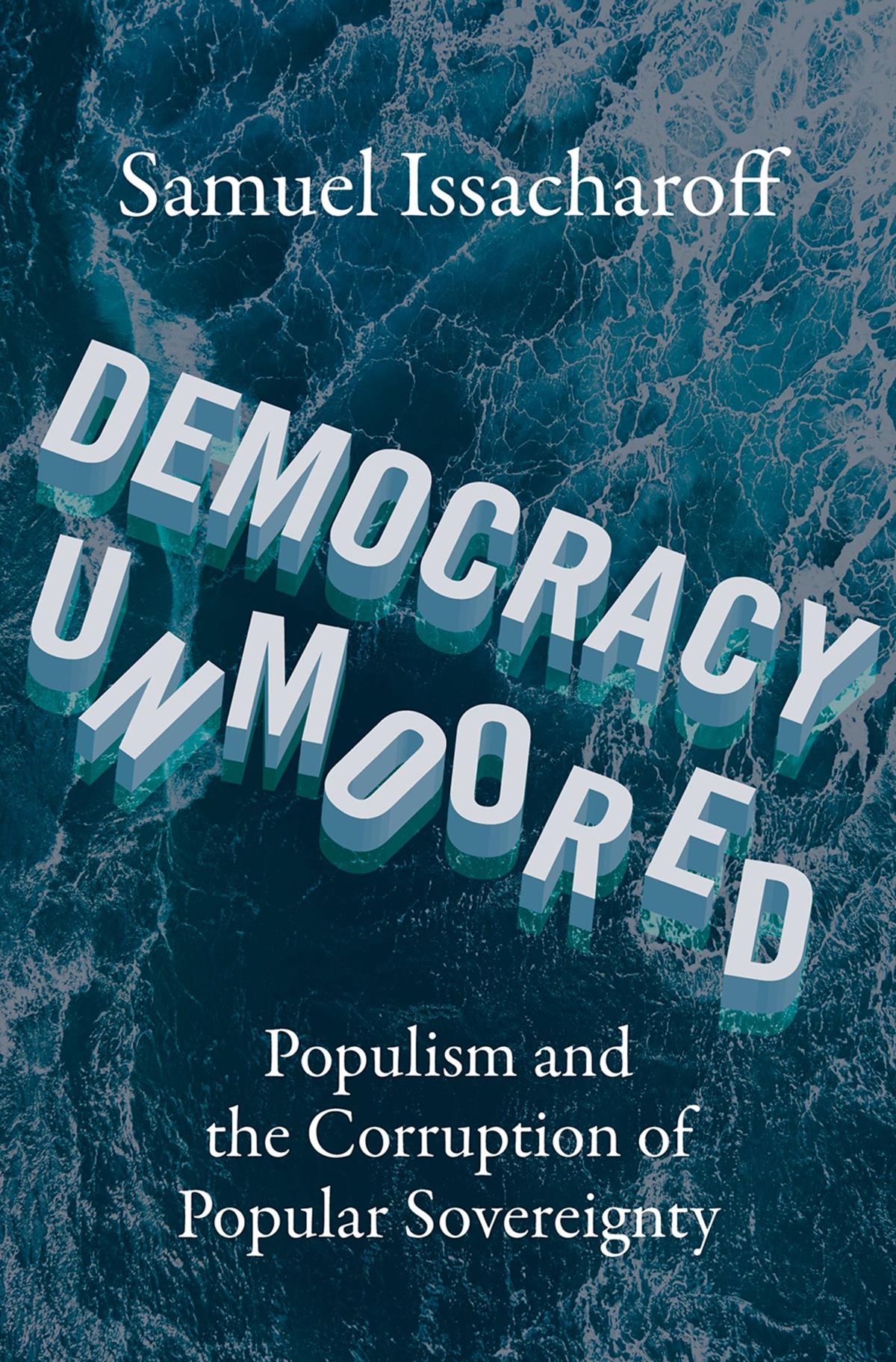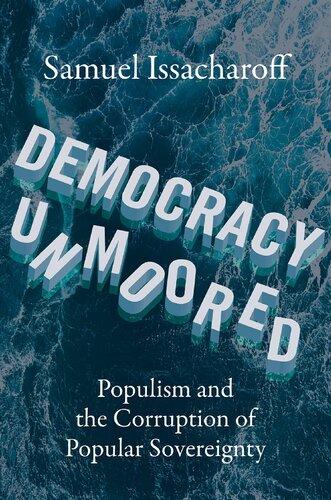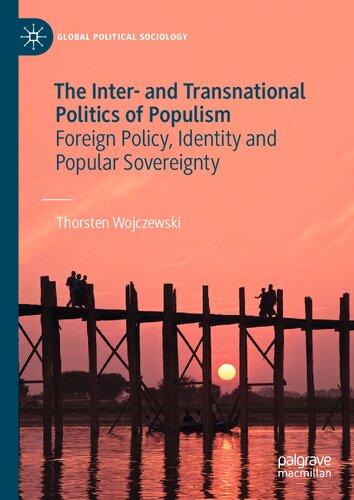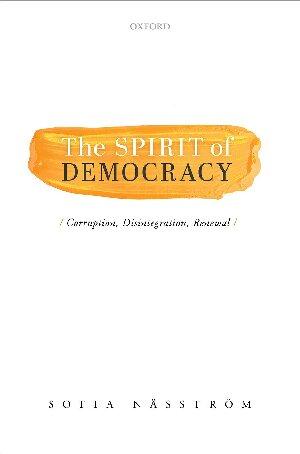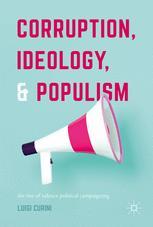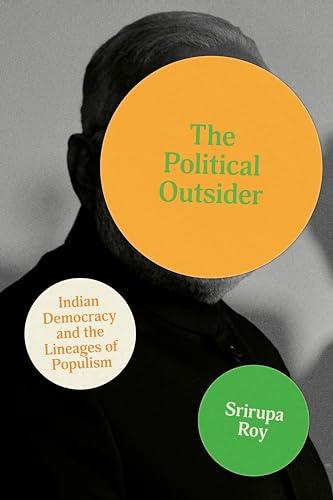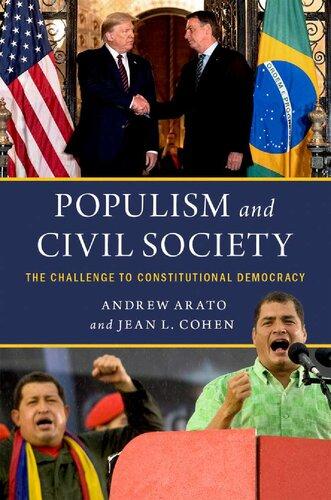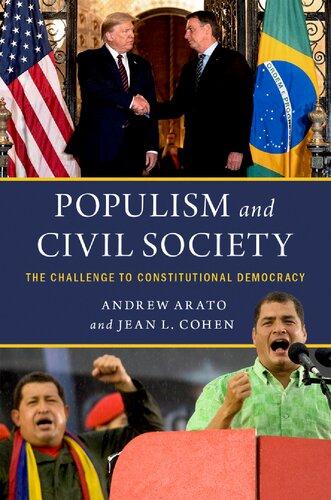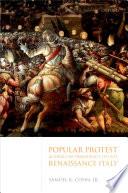Democracy Unmoored
Populism andthe Corruption ofPopular Sovereignty
SAMUEL ISSACHAROFF
Oxford University Press is a department of the University of Oxford. It furthers the University’s objective of excellence in research, scholarship, and education by publishing worldwide. Oxford is a registered trade mark of Oxford University Press in the UK and certain other countries.
Published in the United States of America by Oxford University Press 198 Madison Avenue, New York, NY 10016, United States of America.
© Oxford University Press 2023
All rights reserved. No part of this publication may be reproduced, stored in a retrieval system, or transmitted, in any form or by any means, without the prior permission in writing of Oxford University Press, or as expressly permitted by law, by license, or under terms agreed with the appropriate reproduction rights organization. Inquiries concerning reproduction outside the scope of the above should be sent to the Rights Department, Oxford University Press, at the address above.
You must not circulate this work in any other form and you must impose this same condition on any acquirer.
CIP data is on file at the Library of Congress
ISBN 978–0–19–767475–8 eISBN 978–0–19–767477–2
DOI: 10.1093/oso/9780197674758.001.0001
For Julian, andthe hope for better tomorrows.
CONTENTS
Introduction: The Populist Challenge
PART I THE WORLD THE POPULISTS FOUND
1. The Frayed Social Fabric of Democracy
2. The Capacity to Govern
3. The Political Institutions of Democracy
PART II POLITICS UNDER POPULISM
4. Populism and the Here and Now
5. Caudillosin Command
6. Judicial Intercession
7. Corruption Simpliciter
8. Institutional Wreckage
PART III A DEMOCRATIC RESTORATION?
9. The Exposed Underpinnings of American Democracy
Epilogue
Acknowledgments
Notes
Index
Introduction: The Populist Challenge
About a decade ago, I found myself alone for dinner one evening in Buenos Aires, the city of my birth. I had a lecture to give the next day, and I had reserved the time alone to prepare over dinner in a typical neighborhood restaurant. Such a “boliche,” in the local porteñoslang, was a comfortable setting to have a meal. I sat down to enjoy typical Argentine fare and the inescapable good wine and turned to my lecture materials. I soon found myself distracted by an excellent soccer match shown on a large-screen TV that had been brought in for the occasion. A couple of glasses of tinto, the reds of Mendoza province, and a close football game, and I accepted that lecture preparation was concluded.
This was no doubt the best of Argentina. Steak, wine, and football. I sat and allowed my thoughts to run to what might have been. What if I had not emigrated to the United States as a young boy? Would I have survived the dirty war of military repression that landed so heavily on my generation? Would I have achieved what became possible in emigration amid the constant economic and political disruptions? But also, would I appreciate the aspects of life in Buenos Aires that are still so alluring to the outside visitor?
Periodically, I would be drawn from the comfortable domain of steak, wine, and football to return to another reality of Argentina, one that well illustrates the central framework of this book. Every few minutes, an announcer would garishly proclaim that the football match was part of La Copa Kirchner. La Copa Kirchner? I had been engrossed in match play and was suddenly thrust back into the reality of Argentine politics. The national championship had been renamed in 2011 for Néstor Kirchner, the former president of Argentina, who had died the year before.
In itself, there is nothing striking about a country honoring a deceased head of state. In the U.S., we think nothing of naming cities, airports, bridges, sporting events, holidays, even clearance sales after our former presidents or other significant figures in our history. But the Argentine story was more complicated. Back in 2007, Néstor decided to forego a run for re-election. But the claim to a legacy continued; instead, he was succeeded as candidate to the presidency by his wife, Cristina Fernández de Kirchner. Cristina, known widely as CFK, proved a strong candidate and became president. Again, not remarkable. In the U.S., we have had the families of the Adams, Harrisons, Roosevelts, and Bushes follow in electoral success. What was distinct was that I was watching the Copa Kirchner in the run up to the presidential election of 2012, in which CFK was running for re-election.
Joy over a perfect Argentine evening quickly turned to deeper concern during the match’s halftime. Instead of the usual sports commentary, the entire halftime show was a tribute to the wise and courageous leadership of Néstor Kirchner, a sign of the ongoing Argentine trauma of Peronism. To the untrained eye of a foreigner stumbling upon this spectacle, the tribute might have appeared as bordering on election propaganda for the incumbent president as successor to the Kirchner legacy. To the more discerning eye, there could be no ambiguity. The government had hijacked the most important domestic sports event to brand it as its own. It was as if a sitting president in the U.S. renamed the Super Bowl as a family tribute.
La Copa Kirchner was hardly an isolated event in the process of government ingratiation with its base. In 2009, the Argentine government under Cristina Kirchner had nationalized the cable television stations that broadcast football matches in Argentina, the Fútbol Para Todos (Soccer for All) program, with the indisputable claim that soccer was the birthright of all Argentines. So by the time of the first broadcast of the Copa Kirchner, there was no doubt of the mass audience for the halftime tribute to Kirchner’s legacy as president. A leading Argentine newspaper, La Nacíon, prompted a scandal by estimating that the Fútbol Para Todos program amounted
to hundreds of millions of dollars of free publicity for the incumbent Peronist ticket of Cristina Fernández de Kirchner. Undeterred, the government then decreed that poorer Argentines may have need for new digital televisions to take advantage of the largesse, and then— only months before the 2012 presidential elections—decreed a new TVs for All program for subsidized purchases of new model televisions.
Government largesse in an election year knew no bounds. It turned out that football was not the only legacy that the Kirchner administration could bestow on all Argentines. For the poor, suddenly there were the Beef for All subsidies inaugurated during the election year. And that was followed by the Dairy Products for All campaign. And to top it off, the program that in translation captures it all—the Pork for All initiative.
Putting aside my reflections of the evening, as scheduled I continued the next day to give a lecture to the Argentine Society of International Law on the use of drones and the legal dimensions of war against nonstate actors. That was the consuming issue of the day for the U.S. and the Obama administration, and one that engaged much of my thinking.
But the image of the halftime political tribute in the midst of an election campaign tugged at me. What are the limits of the use of executive power in a democracy? How can democracy ensure electoral accountability in the increasing world of executive domination? What happens when the executive dominates the legislature through partisan alignment, as argued in the American context by my colleagues Daryl Levinson and Richard Pildes,1 or simply through the accretion of unilateral administrative authority?
Upon further reflection, I realized that this was not a new question for me. Encountering the use of great executive power to tilt the playing field of what remained formally an electoral democracy was an ongoing feature of the 21st century. I had dramatically encountered a similar set of issues only a few years earlier.
In 2006, on the eve of Hugo Chávez’s re-election as president of Venezuela, I found myself sneaking into a hotel room in Caracas for
a meeting with the heads of the major opposition newspapers and television stations. I was in Venezuela to give some lectures on freedom of the press at the invitation of the State Department, a challenging tour given the virulent anti-Americanism of the regime. By the time I got to this hotel room, a newspaper site I was supposed to speak at had been blown up the night before, and things had been thrown in my face while lecturing at the University of Caracas.
But that hotel meeting allowed me to understand the new world of incipient authoritarianism. Would-be autocrats around the world no longer relied on the detention camps, the tanks in the street, the machine guns in the hands of soldiers on the street corner. What Venezuela rolled out, the “Chávez playbook,” was a new form of repression within the law, substituting intralegal abuse for the crude human rights abuses of yesteryear.
The independent media of Venezuela described a world that today seems almost routine. Vilification of the press, accusations of faking the news, and claims of being foreign agents were the first layer of an increasingly charged information environment. Pro-government publishers found themselves with privileged access to state information and interviews. Government public service advertisements doled out on a strictly partisan basis provided a blatant subsidy for Chávez-friendly newspaper views. Demands for government access for prime-time presidential discourses (la hora del comandante) cut into important advertising time for the networks, threatening their financial viability. For the progovernment media, lavish state buys were ready substitutes. For the less servile, the bottom-line consequences were severe.
Most unexpected, however, was the answer to my question of the most immediate threat to journalistic independence. For the newspaper editor directly next to me, the answer came quickly. He recounted dozens of defamation suits brought directly or indirectly by the government as a result of his newspaper’s articles and editorials. Even more surprising was the burst of laughter from the other fifteen people in the room. I was stunned. I protested that they must understand the tremendous resources of time, money,
and will that would be necessary to defend one’s integrity against repeated legal processes. They then made clear that I had no idea why they were laughing.
In turn, they each recounted the defamation suits filed against them. The first to speak had almost one hundred. Then the numbers piled up with each successive speaker. By the time the director of the leading all-news station spoke, the numbers were astronomical. This one brave journalistic leader reported over 5,000 defamation actions against him. They had laughed at the first speaker not because this was not a huge attempt to silence dissent but because of the relatively modest number of lawsuits that the first journalist had encountered thus far.
While the confrontation with the growing illiberalism of the Chávez regime was arresting, I could not help but be aware we were meeting up in the hills of East Caracas, the wealthier precincts of that divided city, near the Caracas Country Club, long the bastion of Venezuelan privilege. The attempt to silence critics through the instrumentalities of law and the state captured the disregard for democracy of the Chávez regime, but it could not explain the regime’s solid base of support. The leafy neighborhoods of East Caracas, as well as the institutions of culture and free expression that were nurtured there, coexisted with wrenching poverty and one of the worst inequalities of wealth among any nation on earth.2
By the end of the 20th century, Venezuela was the richest nation in all of Latin America,3 a resounding success story not only economically but also based on its status as a strong, uninterrupted democracy, which stood out compared to its neighbors.4 Unfortunately, as is the fate that befalls countries relying on extractive industries, a subsequent drop in oil prices doomed Venezuela. Moisés Naím, Venezuela’s minister of trade and industry from 1989 to 1999, observed in 2001:
The disappearance of the party system that dominated Venezuelan politics for more than four decades was not a sudden, Soviet-style collapse resulting from an excessive concentration of power in the hands of a small clique of politicians; in fact, Chávez’s ascendancy owes more to the long-term dilution of the political power once held by Acción Democrática (AD) and COPEI, Venezuela’s two main political parties.5
Indeed, from Naím’s vantage, the policy package that exacerbated inequality in the mid-1990s represented two factors. First, entrenched political actors becoming detached from local forces like labor unions, and, second, a full-scale capitulation to “anti-elite” sentiment:
During this period, the two political parties that were the building blocks of Venezuelan democracy for more than five decades lost almost all of their influence, as did the country’s business, labor, and intellectual elites. A new set of hitherto unknown political actors emerged, along with new rules of the game. Elections and referenda proliferated, with voters going to the polls five times in 18 months during 1999 and 2000.6
The following day rounded out the picture of the popular support that would lead to Chávez’s re-election. I was flying back to the U.S., but a tropical downpour and a mudslide had taken out the modern highway bridge that connected downtown to the airport. Instead, I had to cross over the old road in the hills above the city, a poorly paved two-lane road that ran through the precarious villages and shantytowns that invariably surround Latin American capitals. Amid the poverty and the signs of gang domination stood out one feature that I had not seen before. In just about every hamlet, there was a spotless, brown hexagonal building in the main square or intersection in perfect repair and freshly painted. Each of those small but distinctive buildings was a health clinic provided for and staffed by the Cuban government. Exporting medical services was no doubt a propaganda effort by Cuba intended to shore up an ally in Latin America. But, who cares? This was medical services for people living in pretty desperate conditions. If access to health services cemented support for Chávez among the laboring poor, it was hard to see this as other than an indictment of
the elites who had so long ruled in Venezuela and used the accumulated oil wealth in ways that left so much of the population at risk. Political gain for the regime? No doubt. But, no one can claim that the U.S. creation of Medicare and Medicaid, or the extension of prescription drug coverage, or the insurance protection of preexisting medical conditions did not redound to the political benefit of each president who brought new health protections to the voters.
Health services in poor regions are only the beginning of the story. In order to cement their electoral base, populist leaders redirected important resources to the poorest parts of the population. For Venezuela, the source was oil revenue. For other populist leaders in the region, such as President Rafael Correa of Ecuador or the Kirchners in Argentina, the gains from the commodity boom of the 2000s permitted genuine redistribution and attention to the neglected sectors of the society. As expressed by advisers to the current Argentine regime, “We’re putting meat on the grill for those who put us in power. . . . The debt can wait.”7 But the cost was a massive expansion of the state sector and the consolidation of economic power in the service of a personalist political agenda. When the oil market became glutted or the seemingly insatiable Chinese demand for soy and other commodities slackened, then suddenly these populist regimes stood exposed amid scandal and insolvency.
Latin America went through this cycle first, but now the same question of how democracy operates in the face of immediate demands of populism confronts the entire democratic world.
These personal observations set the foundation for this book. The inquiry begins with the simple observation that democracy today is under siege, but from a source that could hardly have been imagined in the world before the fall of the Berlin Wall. For much of the 20th century, the existential threat to democracy was authoritarian rule. The modern language of human rights was born to thwart the usage of state authority in bending the population to
the will of the rulers. Human rights defined the inalienability of an irreducible core of human dignity. The rights holder was the individual at risk. In turn, this rights discourse became the lingua franca of the empowered judiciary that took hold in Europe after World War II and then across so much of the world in the post-1989 third wave of democratization.8
The 20th century closed with a certain vision of market-based liberal democracy triumphant against its ideological rivals of fascism and communism. The imprecise contours of ascendant democracy included generally robust markets, welfarist protections for citizens, a broad commitment to secularism (even in countries with an established church), and liberal tolerance of dissent and rival political organizations. All this was packaged in robust constitutional protections of civil liberties and the integrity of the political order. And, characteristic of the era, all was under the supervision of increasingly commanding constitutional courts or other apex tribunals.
These features were sufficiently widespread that a great deal of imprecision could be accepted in the exact pedigree of this new world order. It was the ascendency of both democracy and of constitutionalism. It represented the triumph of liberalism and the realization of the Enlightenment project. It was both the vindication of capitalism and the realization of the state of social welfare. Precisely because it seemed to be all at once, the conflict between majoritarian politics and constitutional restraint, between the creative destruction of markets and social guarantees, between liberty and security, all could be pushed aside.
The fall of the Soviet empire was the crowning achievement of the postwar democratic order. Yet, the triumphant era of what Samuel Huntington termed the third wave of democracy would not last much into the new millennium.9 The democratic euphoria following the fall of the Berlin Wall barely ran its course before it confronted a new virulent reaction to the new modern imperium. In short order, Islamic-inspired terror introduced a malevolent new international actor. The Arab Spring collapsed into familiar patterns of tyranny or,
as in Syria, violent communal strife. By the early 2000s, a number of newly minted democracies were retreating to customary forms of autocratic rule.
But the biggest shocks came not from the periphery but from within the established democratic order. These shocks were not the product of military conflict or attempts at violent overthrow but were instead largely prompted by economic insecurity and the changing demographics of a globalized world. Populist upsurges from right and left revealed the disrepair of the post–World War II general consensus of politics in the democratic world. From France to India, the historic parties such as Congress, the socialists, and the Gaullists were discredited and effectively pushed outside the political order. Brexit prevailed over strenuous opposition from within both the Tories and Labour. The American presidential election of 2016 featured a determined Democratic run by Bernie Sanders, not even a member of that party, and the eventual victory by President Trump, a candidate with only fleeting relations to the Republican Party. The new political challenge saw democracy not as the culmination of the postwar era but as a failed elite endeavor that had left the laboring classes vulnerable. Populist leaders, from left and right, learned to bypass institutionalized forms of politics in favor of direct and frequent communications with the population, from Hugo Chávez’s frequent multi-hour television appearances to Donald Trump’s infatuation with Twitter.
Even before the dramatic assault on the U.S. Capitol in the waning hours of the Trump presidency, ascendant populism had made clear its rejection of the foundations of modern democratic governance. The secret to democratic stability is repeat play, which requires an extended time horizon. Time allows the losers of today the prospect of reorganizing and emerging as the winners of tomorrow. An election may yield a bad result, the tenor of the era may prompt poor legislation, but what remains critical is the capacity to recover. The American experiment in democratic self-rule was consolidated in the election of 1800, which represented the first time a head of state had been removed through electoral means. In his wide-eyed review of American democracy, de Tocqueville thought that the key to non-
aristocratic rule was the capacity to make what he termed retrievable mistakes.10 At the time, he assumed that the challenge to successful democratic governance would be military intercession, as with the disastrous War of 1812, that would shorten the time horizon needed for republican prospects.
The constricting force today is not external but internal, notwithstanding the continuing threats of terrorism and the reorganization of international relations in light of Chinese ascendancy. Populist impulses shorten the time frame of relevant political consequences and turn everything into a bimodal choice, a political life defined by existential issues. Us or them, success or perfidy, the people or the oligarchs, our nation or foreigners. There can be no spirit of partial victory, of legitimate disagreement, or even of mutual gain through engagement. The effects of compressed time horizons can be seen in the willingness to discard long-standing institutional rules that protect the minority, such as the Senate filibuster in the U.S., in favor of immediate political gain. Efforts to alter election rules or the powers held by elected governments, as shown in the American context in North Carolina or Wisconsin, are perhaps the most combustible manifestation of the current challenge to the necessary long horizon of stable democratic governance. The stable democracies pass from being a challenge among adversaries to an unyielding battle against enemies, to borrow from Michael Ignatieff.11
Democratic politics under the sway of populism loses the sense of collective enterprise among all political actors. Not only does the commitment to repeat play drop out, but so does the limitation on what the victors can expect to do. Modern democracies govern through institutional arrangements that run the gamut from separation of powers at the formal level of the state to the private associations that provide stability and continuity over time, most notably the political parties that undergird a stable political order. Populism, noted Isaiah Berlin a half century ago,
is not principally interested in political institutions, although it is prepared to use the state as an instrument for the purpose of producing its ends. But a state organization is not its aim and the state is not its ideal human association. It believes in society rather than in the state. . . . All these movements believe in some kind of moral regeneration. . . . There must have been a spiritual fall somewhere. Either the fall is in the past or it is threatening—one of the two. Either innocence has been lost and some kind of perversion of men’s nature has occurred, or enemies are breeding within or attacking from without.12
This book will largely follow Berlin’s diagnosis of populism as being grounded in political mobilization in disregard of the institutions of governance. Much has been written on the economic preconditions for the current populist surge,13 and the role of failing economic fortunes in prompting a backlash in politics,14 particularly in the face of immigration.15 Others have focused on the role of social media in allowing mass incitement outside the boundaries of established political institutions.16 Many ground the investigation in the particulars of a single country.17 Others, most notably Jan-Werner Müller, look to the clientelism and demagogy that are characteristic of populist leaders.18
Each of these approaches captures an important strain of the nature of populism and its threat to democratic governance. For present purposes, however, the striking feature is the antiinstitutionalism of populism both as a political movement and as a governance strategy. The attack on Congress’s ceremonial function of counting the electoral votes for president is both symbol and substance of the war on inherited forms of governance. In the assault of the immediate, democratic institutional arrangements are particularly vulnerable.
Populist elections claim a mandate from the people that goes beyond choosing officeholders. Elections over mandates risk the same repudiation of institutional accommodation of divisions as do plebiscites. It is not that populism is plebiscitary as such; rather, neither is well suited to institutionalized politics that presume deliberation, procedural order, and compromise. For both plebiscites
and populism, the immediate election defines the agenda. Both populism and plebiscites look to the maximal leader rather than the legislature as the source of deliverance. In turn, the ensuing caudillo politics yields a web of cronyism, corruption, and clientelism all turning on relations to the commander.
Previously my attention was devoted to the distinct frailties of new democracies as they emerge from conflict or an autocratic past.19 One of the defining characteristics is that the complete package of democratic institutions rarely mature together, or quickly. Democracy proves to be a complicated interaction among popular sovereignty, political competition, stable institutions of state, vibrant organs of civil society, meaningful political intermediaries, and a commitment to the idea that the losers of today have a credible chance to reorganize and perhaps emerge as the winners of tomorrow. Few if any of these criteria are likely to be satisfied amid the birth pangs of a new democratic order.
What is striking in the current era is that the mature democracies encounter the same forms of institutional failure as the necessarily weak nascent democracies, even if the clock seems to be running in reverse. In virtually all democracies, the populist onslaught is accompanied by the increased command of a hypertrophic executive. There are the odd exceptions as in Poland, where power is effectively wielded from outside the formal command structure of the state, but populist governance yields strongman rule, regardless of the national setting. As a result, any explanation of the weakness of democratic politics in the face of populism cannot rest on the merely conjunctural. The weak recovery from the financial crisis of 2008 certainly provides fuel to the fire. But the seemingly overnight rise of populist challenges and the failures of conventional postwar political institutions to channel the political upsurge requires greater explanation.
It is also possible to root particular populist impulses in domestic national settings. No doubt reforms in American laws governing political parties and campaign finance have weakened the parties as institutions. Similarly, persistent weak government in Britain under
an unstable coalition contributed to the Brexit upheaval. And Italy had Berlusconi, Spain had the housing bust, France had untenably high unemployment, and so on. But the persistence of this pattern across stable democracies prompts an inquiry beyond the national level. Unlike the populist wave that swept Latin America in the early 2000s, populism in the U.S. and Europe is not aspirational in terms of national policy but angry at a sense of loss and betrayal. As expressed by Cas Mudde and Cristóbal Rovira Kaltwasser:
Whereas in Latin America the emphasis is on establishing the conditions for a good life for “the people,” in Europe populists primarily focus on protecting these conditions, which they consider increasingly threatened by outside forces (notably immigrants). Hence, their prime focus is on the exclusion of the outgroups rather than on the inclusion of (parts of) the ingroup.20
The sense of loss provides the combustible material for a charismatic leader organizing on the basis of rejection of customary politics and the institutional order. True, Jarosław Kaczyński does not command charismatically, and Brexit caught on without a dominant individual at the head of the movement. Nonetheless, the standard mix is familiar across the democratic world. Cas Mudde elaborates:
The populist heartland becomes active only when there are special circumstances: most notably, the combination of persisting political resentment, a (perceived) serious challenge to “our way of life,” and the presence of an attractive populist leader. However, what sets the populist heartland apart from other protest-prone groups is their reactiveness; they generally have to be mobilized by a populist actor, rather than taking the initiative themselves.21
Behind the momentary events in any particular country stands the perception of democratic rule serving as cover for the failure of elites to address the security and prosperity of citizens of the advanced democratic societies. Much as the topic at hand opens the door to all sorts of failings of modern democracy, the immediate task must remain narrower. To return to the opening theme, the challenge to democracy is not primarily state repression but institutional failure.
The language of human rights poorly captures the tension when the electoral choice of the voting public is impulsive, demagogic, unconstrained by the language or norms of governance, and oftentimes publicly committed to unwinding the very institutional arrangements that allowed populist electoral success in the first place. The mark of the authoritarian regimes of the 20th century was the ready recourse to extralegal means of oppression to reinforce brute power. By contrast, the current populist leaders rely heavily on their electoral mandate and choose the means of intralegal mechanisms to wear their opponents down. Rather than tyranny wielded by a state-enabled minority, populism risks the tyranny of the majority threatening to break through institutional constraints.
In turn, the altered nature of the threat to democratic integrity requires a different metric for legal intervention, one separated from the customary protection of individual autonomy that characterizes the primary human rights domain. It is important to emphasize, as do Levitsky and Way, these regimes are dependent on electoral approbation as the foundation of political legitimacy, and the combination of “meaningful democratic institutions and authoritarian incumbents creates distinctive opportunities and constraints.”22 Following their definition, these are “civilian regimes in which formal democratic institutions exist and are widely viewed as the primary means of gaining political power, but they are not democratic because the playing field is heavily skewed in favor of incumbents. Competition is thus real but unfair.”23 To the extent that opponents of current populist demagogues engage in facile comparisons of such elected authoritarians to Nazis or fascists or communists, they are wide of the mark. Whatever the autocratic inclinations of the rulers,24 these are not the authoritarian regimes of yesteryear. The question then becomes whether there are forms of legal intervention that may preserve democratic accountability by frustrating the populist claim to permanence. In what follows, I address three primary issues. First is the sources of populist ascendency against the established democratic order of the post–
World War II period. Second, I turn to the institutional dimensions of populist governance. And third (and with the most difficulty), I address the reforms that might restore some sense of order in the house of democracy. Each of the three parts of the book focuses on the relation between populism and how a democratic society is governed. The thesis that will emerge is that the populist insurgency following the 2008 financial debacle found democracies with weak and poorly performing governance institutions. In turn, populist politics took aim at these institutional buffers, what Levitsky and Ziblatt usefully term the “guardrails” provided by state institutional practices.25 The toxic combination of weak governance and the populist assault contributed to a world of increasingly autocratic elected leaders. Finally, the institutional inquiry frames the hardest part of the enterprise: considering what ameliorative steps might be on the agenda.
PART I
THE WORLD THE POPULISTS FOUND
The Frayed Social Fabric of Democracy
It is difficult to recapture the optimism that filled the democratic world only a quarter century ago. It was not just that the 20th century saw the defeat of the great ideological challenges of fascism and communism. It was also the sense that, unbound from authoritarianism, the forces of democratization and markets would unleash a world of freedom and prosperity unmatched in human history. Certainly there was merit to the claim. In short order, more humans were able to select their rulers in reasonably free elections, state repression waned, and expressive liberties reached the far corners of the globe. Perhaps more impressive, the period between the fall of the Berlin Wall and the financial crash of 2008 saw more people lifted from poverty than at any other time in human history— indeed, more than most would have thought possible. It seemed that the proponents of democratic governance and liberal freedoms were poised for a well-merited victory lap.
On this victory lap, democratic enthusiasts could observe that, over the past two centuries, democracies had outfought, outinnovated, and out-produced their rivals. With singular capacity, democracies raised the living standards of the broad masses of their populations, raised education levels to permit citizen engagement, and at the same time were able to trust powerful militaries to protect them from foreign assault without themselves succumbing to military rule. History is obviously much more complicated, and this is a somewhat tendentious reading, but it captures the ideological consensus that prevailed after the collapse of the Soviet empire and the brief era of apparent democratic universalism.
For many observers, myself included, the question of the day was how quickly these newly liberated parts of the world would achieve the levels of prosperity and liberty associated with the advanced democratic countries. And indeed, many countries went on to hold elections for heads of state and legislatures. But rotation in office and toleration of the opposition and of rival political parties developed slowly or not at all. By 2006, the democratic tide was receding and the number of countries classified as democratic began to decline.1 Certainly, the retrocession took place in some of the former Soviet Republics of central Asia and southeastern Europe, regions that seemed foreboding terrain for democracy under any circumstances. In hindsight, elections and the appearance of democratic choice were the product of a temporary disruption of strongman rule, unlikely to survive the first reconsolidation of state authority.2
Yet lurking behind democratic triumphalism were signs that the foundations of democracy inherited from the 19th century were eroding. It was these foundations of citizen engagement and elite commitment to electoral accountability that had allowed these democracies to prevail across what Philip Bobbitt terms the “long war” of the 20th century.3 When World War II dispatched the forces of fascism, the history of the second half of the 20th century became the battle of democracy against the communist empire of the Soviet Union and its client states, at least until the independent rise of China. Unlike the decisive defeat of the Axis powers in World War II, there never was a decisive military confrontation with the Soviet Union. Instead, there were brutal but confined conflicts in Korea and Vietnam, hosts of proxy wars from Indonesia and the Philippines to Central America, and even confrontations whose Cold War underpinnings may now be obscured. To give just one example, the United States backed the apartheid National Party of South Africa while the Soviet Union funneled resources to the African National Congress. The decades long struggle against South African racialism quickly came to a close after the fall of the Berlin Wall.
In hindsight, the ultimate battlefield of the Cold War was economic. To be sure, there was a military component to the economic contest. The maintenance of the Soviet bloc and the arms race with the U.S. took a tremendous economic toll, especially with the escalation of the latter by the Reagan administration. But the struggle for the hearts and minds of the world, as well as the loyalty of the West’s working classes to the capitalist order, was waged in terms of what a market economy versus central planning could deliver.
Looking ahead to the 21st century, the critical challenge to democracy would emerge when that market order largely ceased to deliver—or at least was no longer perceived to tilt upward—to greater generalized prosperity. No account of the rise of populism in the 21st century can ignore the erosion of working-class incomes in the advanced industrial countries over the last decades of the 20th century. Whatever sentiments of nationalism, xenophobia, and outright racism might infect the current populist surge, any fair rendering begins with the sense of economic insecurity among the laboring classes.
Consequently, the account of democratic decline must begin in the economic domain.
I. Freedom from Want
On January 6, 1941, Franklin Roosevelt delivered a transcendent State of the Union Address, preparing the nation for the likelihood of war and taking the first steps with the Lend Lease Program, thereby offering a lifeline to the United Kingdom, and setting the nation on the path to direct confrontation.4 The speech is remembered for its proclamation of Four Freedoms, including “freedom from want which, translated into world terms, means economic understandings which will secure to every nation a healthy peacetime life for its inhabitants—everywhere in the world.” Together with freedom of expression, freedom of worship, and freedom from fear, the address
introduced a guarantee of material well-being into the arsenal of democracy.
The inclusions of material security as one of the essential freedoms provided the ideological linchpin for the New Deal and its radical expansion of the welfarist state. At the same time, the speech redefined international relations by inviting competition over the ability to provide enhanced social welfare for the citizenry. The Four Freedoms transformed the claims for the superiority of democracy against other social orders. Roosevelt’s speech served as “the moral backbone behind the establishment of the United Nations, and it informed the creation of both the European Union and NATO. If the New Deal was . . . a project comparable only to the French Revolution in its enduring political significance, then the Four Freedoms address was its Declaration of the Rights of Man and Citizen.”5
That economic commitment provoked immediate dissent from market apostles such as Friedrich Hayek and backers in the banking class still harkening for the Gilded Age before the Great Depression. For them, “what was promised to us as the Road to Freedom was in fact the High Road to Servitude.”6 As Hayek was to sum up several decades later, Roosevelt’s claim that democratic freedom encompassed not just liberty but also economic returns to ordinary citizens mandated state responsibility inconsistent with a classic liberal commitment to laissez-faire. Such promises, the argument ran, “could not be made universal within a system of rules of just conduct based on the conception of individual responsibility, and so require that the whole society be converted into a single organization, that is, made totalitarian in the fullest sense of the word.”7
Following the Depression, the world war, the reconstruction of Europe under the Marshall plan, and the emergence of social democratic commitments in the postwar period, the arguments about democracy as limited to the preservation of autonomous individual liberties ceased to define the era. In the U.S., once the Four Freedoms became enshrined in the iconic paintings of Norman
Rockwell (Figure 1.1), the ability to deliver prosperity to the masses became not only a centerpiece of the claimed superiority of democracy and markets but also the keystone of the American century.
Figure 1.1 Norman Rockwell, FreedomfromWant(1943).
For my parents who watched the Hollywood movies of the postwar era in Argentina, the splendor of America seemed overwhelming. An actor unable to sleep would wander to the kitchen to open what seemed to be a massive refrigerator door and grab a leftover chicken drumstick to snack on. Seen from a country where refrigerators were only then coming within the reach of consumers and where chicken was a luxury item (oddly, beef was a staple), the combined image of a home refrigerator and excess chicken was beyond reach, if not simply inconceivable.
Fast forward to the height of the Cold War period and the “cultural exchange” between the U.S. and Russia in the late 1950s. At that point, the freedom from want championed by Roosevelt was no longer simply the broad justification of New Deal intervention into economic affairs to restore security following the Great Depression. Rather, freedom from want, and indeed growing affluence, became the challenge of the American century to non-democratic states as incapable of delivering prosperity to their citizens.
An illustrative high point was the construction of exhibit halls by Russia in New York City and by the U.S. in Moscow. When the Moscow exhibit opened in 1959, Vice President Nixon escorted Premier Khrushchev through a model American home filled with devices unknown in the Soviet Union, such as color television sets. But it was in the model kitchen, of the sort that so impressed my parents in Argentina, that Khrushchev famously blew up at Nixon and proclaimed, “We have powerful weapons, too, and ours are better than yours if you want to compete.”8 The tension between the two was building throughout the engagement, but it begs noticing that the final trigger appeared to be the labor-saving devices and small kitchen luxuries available to ordinary Americans everyday. Khrushchev’s outburst began with the promise—never realized—that the Soviet Union would overtake the U.S. in providing material comforts for its working population.
A similar story may be told about Europe in the postwar period. The 1972 Munich Olympics will forever be associated with the massacre of Israeli athletes and, quite secondarily, with the
introduction of systematic doping by the East German delegation. But 1972 also played an important role in destabilizing the Soviet bloc. East Germany had only recently been afforded member status in the Olympic community, and the regime wanted to show off Soviet-era athletic prowess (before the doping came to light) as evidence of superiority over the West. As a result, East Germany allowed for live broadcasting of the Munich Olympics to a population that had been fed a steady diet of regime propaganda about the imminent collapse of the capitalist world. What captivated East Germans were the live television images of the magnificent West German roadways around Munich, the elegance of the street life, and the size and quality of the automobiles.9 For a population barely recovered from the wartime devastation of the country a quartercentury earlier, the images starkly undermined all the claims about East German superiority, particularly with regard to the living standards of the mass of working people.
Material well-being sustained a complicated faith of working people in Western democracy. Over the postwar period, support for the Western communist parties steadily fell, and the social democratic left, deeply rooted in the trade union movement, emerged as a dominant political actor in country after country. Working-class loyalty to unions and center-left political parties provided stability for democracies, even across the cultural upheavals of the 1960s. The political dynamics were defined by the national setting, and some social democrats found themselves in coalition governments with increasingly domesticated Communist Parties. Others, including the American Democratic Party, remained staunchly anticommunist, while following a similar trajectory of generous labor rights and state welfarist policies.
A similar story could be told across the aisle for centrist democratic politics. Christian Democrats in Europe, the Tories in the UK, and the Republicans in the U.S. all offered a similar solicitude to the material aspirations of small businesses, farmers, and other vulnerable entrepreneurs who a generation or two previously might have been seduced by fascists or the nativist right. Here, too, the
